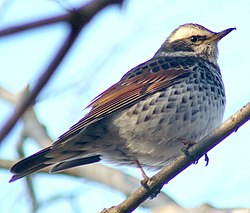鶇
Appearance
| ||||||||
Translingual
[edit]Han character
[edit]鶇 (Kangxi radical 196, 鳥+8, 19 strokes, cangjie input 木田竹日火 (DWHAF), four-corner 57927, composition ⿰東鳥)
References
[edit]- Kangxi Dictionary: page 1493, character 21
- Dai Kanwa Jiten: character 47054
- Dae Jaweon: page 2023, character 29
- Hanyu Da Zidian (first edition): volume 7, page 4639, character 11
- Unihan data for U+9D87
Chinese
[edit]Glyph origin
[edit]Etymology 1
[edit]| trad. | 鶇 | |
|---|---|---|
| simp. | 鸫 | |
| alternative forms | 𪂝 | |
Pronunciation
[edit]- Mandarin
- (Standard Chinese)+
- Hanyu Pinyin:
- Zhuyin: ㄉㄨㄥ
- Tongyong Pinyin: dong
- Wade–Giles: tung1
- Yale: dūng
- Gwoyeu Romatzyh: dong
- Palladius: дун (dun)
- Sinological IPA (key): /tʊŋ⁵⁵/
- (Standard Chinese)+
- Cantonese
- (Standard Cantonese, Guangzhou–Hong Kong)
- Jyutping: dung1
- Yale: dūng
- Cantonese Pinyin: dung1
- Guangdong Romanization: dung1
- Sinological IPA (key): /tʊŋ⁵⁵/
- (Standard Cantonese, Guangzhou–Hong Kong)
- Middle Chinese: tuwng
- Old Chinese
- (Zhengzhang): /*toːŋ/
Definitions
[edit]鶇
- Used in 鶇鵍 (“name of a kind of bird”).
Etymology 2
[edit]| trad. | 鶇 | |
|---|---|---|
| simp. | 鸫 | |
Pronunciation
[edit]- Mandarin
- (Standard Chinese)+
- Hanyu Pinyin:
- Zhuyin: ㄉㄨㄥ
- Tongyong Pinyin: dong
- Wade–Giles: tung1
- Yale: dūng
- Gwoyeu Romatzyh: dong
- Palladius: дун (dun)
- Sinological IPA (key): /tʊŋ⁵⁵/
- (Standard Chinese)+
- Cantonese
- (Standard Cantonese, Guangzhou–Hong Kong)
- Jyutping: dung1
- Yale: dūng
- Cantonese Pinyin: dung1
- Guangdong Romanization: dung1
- Sinological IPA (key): /tʊŋ⁵⁵/
- (Standard Cantonese, Guangzhou–Hong Kong)
Definitions
[edit]鶇
Compounds
[edit]- 烏鶇 / 乌鸫 (wūdōng)
- 白腹鶇 / 白腹鸫 (báifùdōng, “pale thrush (Turdus pallidus)”)
- 磯鶇 / 矶鸫 (jīdōng)
Japanese
[edit]Alternative forms
[edit]- 鶫 (kokuji: Japanese-only)
Kanji
[edit]鶇
- a thrush (bird)
Readings
[edit]Etymology
[edit]
| Kanji in this term |
|---|
| 鶇 |
| つぐみ Hyōgai |
| kun'yomi |
From the 連用形 (ren'yōkei, “continuative or stem form”) of verb 噤む (tsugumu, “to shut up, to become quiet”), from the way the birds cease singing after summer has ended.
Pronunciation
[edit]Noun
[edit]- a thrush: a bird of genus Turdus
- (more specifically) a dusky thrush: Turdus eunomus
Usage notes
[edit]As with many terms that name organisms, this term is often spelled in katakana, especially in biological contexts (where katakana is customary), as ツグミ.
Derived terms
[edit]References
[edit]- ^ Matsumura, Akira, editor (2006), 大辞林 [Daijirin] (in Japanese), Third edition, Tokyo: Sanseidō, →ISBN
- ^ NHK Broadcasting Culture Research Institute, editor (1998), NHK日本語発音アクセント辞典 [NHK Japanese Pronunciation Accent Dictionary] (in Japanese), Tokyo: NHK Publishing, Inc., →ISBN
Categories:
- CJK Unified Ideographs block
- Han script characters
- Translingual lemmas
- Translingual symbols
- Chinese lemmas
- Mandarin lemmas
- Cantonese lemmas
- Middle Chinese lemmas
- Old Chinese lemmas
- Chinese hanzi
- Mandarin hanzi
- Cantonese hanzi
- Middle Chinese hanzi
- Old Chinese hanzi
- Chinese terms with IPA pronunciation
- Chinese terms spelled with 鶇
- Chinese nouns
- Mandarin nouns
- Cantonese nouns
- zh:Zoology
- zh:Thrushes
- Japanese kanji
- Japanese hyōgai kanji
- Japanese kanji with goon reading つう
- Japanese kanji with kan'on reading とう
- Japanese kanji with kun reading つぐみ
- Japanese terms spelled with 鶇 read as つぐみ
- Japanese terms read with kun'yomi
- Japanese terms with IPA pronunciation
- Japanese lemmas
- Japanese nouns
- Japanese terms spelled with hyōgai kanji
- Japanese terms with 1 kanji
- Japanese terms spelled with 鶇
- Japanese single-kanji terms
- ja:Thrushes


